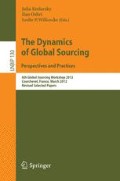Abstract
Our research points to the considerable promise of Cloud [1], and the even bigger opportunity waiting to be grasped.However, this is all before us in a future still undetermined, despite confident predictions of very large revenues and business benefits from cloud technologies within 2-3 years. If ‘the mark of a successful technology is that it vanishes,’ [2] then cloud computing has a long way to go. Not only has it been the most visible technology by far in the last three years, but this looks likely to continue for the next three. Leaders in industry and governments worldwide find themselves on the cusp of potential major deployment of these technologies but find themselves at a key Stop, Think, Act moment. In the face of business demands, technological developments and the maturing of external services, CIOs, in particular, need to be thinking about, and revisiting, what their technology organizations need to look like three to five years out. Managing cloud deployment on a project-to-project or six months-to six months basis, is not going to achieve technological integration, optimize cloud deployment, or deliver on the agenda businesses are setting for cloud. CIOs will be looking at their strategy, capabilities, operating model and ability to execute, how cloud fits with their existing technologies and organization, and its implications for this industry, and this business – because there is no single cloud, and it is going to be different for every organization. Ultimately it is management that will make the difference. And for management, there is a (very large) sting in the tail. In the face of the forthcoming data explosion, the problems organizations have always had with optimizing their use of information are just about to get much, much, more difficult. This brings to the fore the need for organizations, and their technology functions, to resist the old compulsion to merely straightjacket the data explosion with superior technology, and instead rethink themselves as digital businesses, and address the importance of business analytics for guiding strategic action and operations [3]. This forward vision will seems ambitious. But it actually represents a convergence whose emerging shape we have been tracking through a range of research studies stretching back to commercial development of the internet from the mid 1990s [4]. How can this world can be managed into existence? What retained capabilities will be needed to run the technology function? What specific management capability challenges and worry-points are coming to the fore with cloud deployment? How can the technology function, and business readiness, be evolved to leverage cloud, the technology platform and applications for business advantage? These are the questions our research in this paper sets out to answer.
Access this chapter
Tax calculation will be finalised at checkout
Purchases are for personal use only
Preview
Unable to display preview. Download preview PDF.
References
Willcocks, L., Venters, W., Whitley, E.: Cloud and The Future of Business 1 – Promise. Accenture/LSE Outsourcing Unit, London (2011)
Simon May of Microsoft, quoted in Sherriff, L. What the future holds. Cloud Business (July 19, 2011)
Nanterme, N., Campbell, K.: For further insight into constructive management responses to this massive data explosion - through data platforms and business analytics. In: Accenture Technology Vision 2011, London (2011)
Kern, T., Lacity, M.C., Willcocks, L.: Netsourcing: Renting business applications and services over a network. FT Press (2002)
Eisenhardt, K.M.: Building theories from case study research. Acad. Manage. Rev., 532–550 (1989)
Golden-Biddle, K., Locke, K.: Appealing work: An investigation of how ethnographic texts convince. Organ Sci., 595–616 (1993)
Overby, S.: CIOs lack adequate cloud computing knowledge. CIO Magazine (2011)
Willcocks, L., Venters, W., Whitley, E.: Cloud and The Future of Business – 2 Challenges (2011)
Willcocks, L., Venters, W., Whitley, E.: Cloud and The Future of Business – 4 Innovation (2011)
Willcocks, L., Venters, W., Whitley, E.: op. cit. (2011)
Willcocks, l. Cullen, S. Craig, A, The Outsourcing Enterprise. Op. Cit., ch. 1 (2011)
Willcocks, L., Cullen, S., Craig, A.: Op. cit. chapter 5 for a detailed analysis with case examples (2010)
Willcocks, L., Lacity, M.: The New IT Outsourcing Landscape: From Innovation To Cloud Services, London (2012)
quoted in Hall, S. 5/4/11 Cloud Architect: Triple Play of Skills. CIO.com and Infoworld 5/4/11
David Linthicum of Microsoft in ‘Why the shortage of cloud architects will lead to bad clouds. Computerworld (July 28, 2011)
Poston, R.S., Kettinger, W.J., Simon, J.C.: Managing the vendor set: achieving best pricing and quality service in IT outsourcing. Mis. Q. Exec. 8, 45–58 (2009)
Willcocks, L., Cullen, S., Craig, A.: The Outsourcing Enterprise: From IT to Collaborative Innovation. Palgrave, London (2011)
Willcocks, L.P., Olson, N., Petherbridge, P.: Making IT count: strategy, delivery infrastructure. Butterworth-Heinemann (2002)
Whitley, E., Willcocks, L.: Achieving Maturity in Outsourcing Capability: Towards Collaborative Innovation. MISQ Executive 10, 95–107 (2011)
Heifetz, R.A.: Leadership without easy answers. Harvard University Press (1994)
Feeny, D. (ed.): The Five Year Learning of Ten IT Directors. McGraw Hill, Maidenhead (1997)
Kyne, F.: Cloud signifies skills change for IT Pros, Citrix says (downloaded from Forbes June 30, 2011)
Author information
Authors and Affiliations
Editor information
Editors and Affiliations
Rights and permissions
Copyright information
© 2012 Springer-Verlag Berlin Heidelberg
About this paper
Cite this paper
Willcocks, L., Venters, W., Whitley, E. (2012). Cloud Sourcing: Implications for Managing the IT Function. In: Kotlarsky, J., Oshri, I., Willcocks, L.P. (eds) The Dynamics of Global Sourcing. Perspectives and Practices. Global Sourcing 2012. Lecture Notes in Business Information Processing, vol 130. Springer, Berlin, Heidelberg. https://doi.org/10.1007/978-3-642-33920-2_9
Download citation
DOI: https://doi.org/10.1007/978-3-642-33920-2_9
Publisher Name: Springer, Berlin, Heidelberg
Print ISBN: 978-3-642-33919-6
Online ISBN: 978-3-642-33920-2
eBook Packages: Computer ScienceComputer Science (R0)

